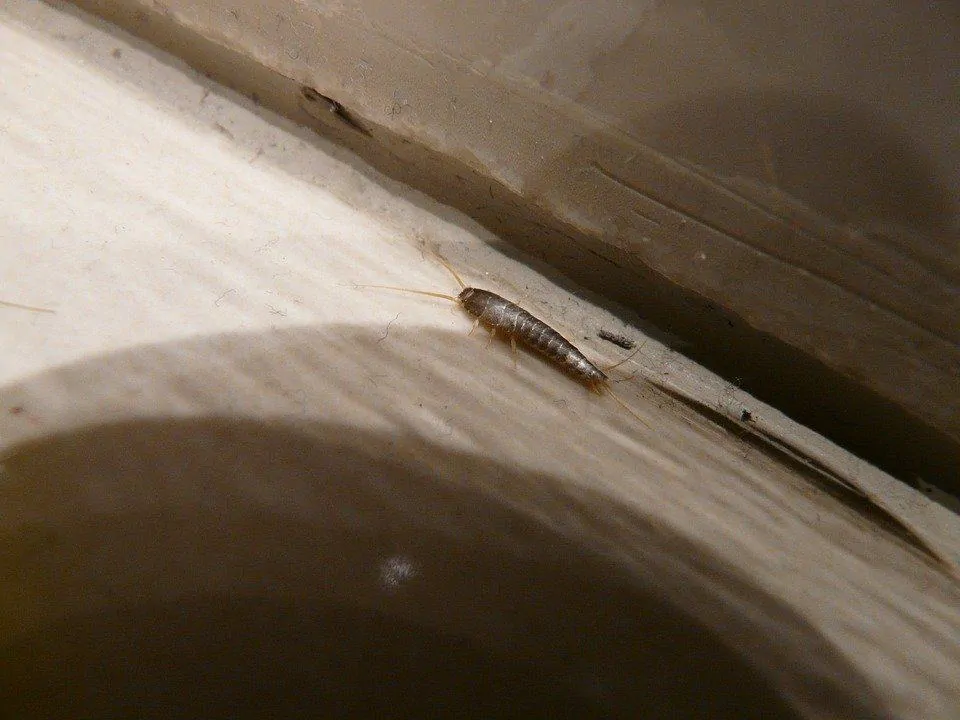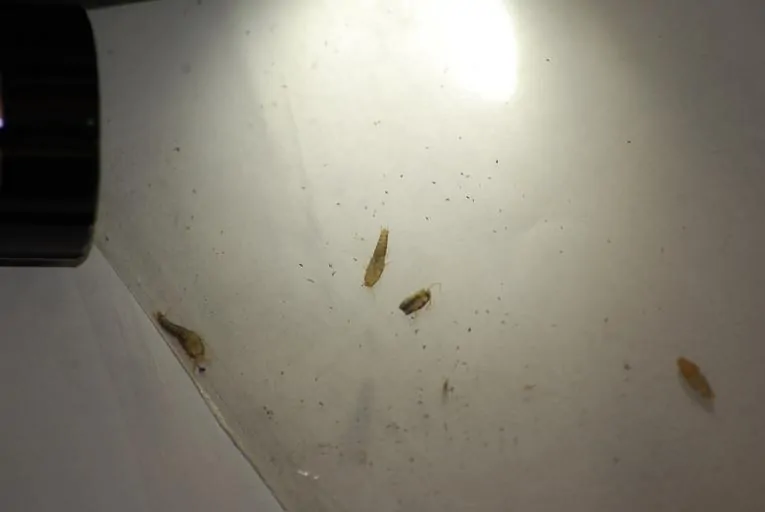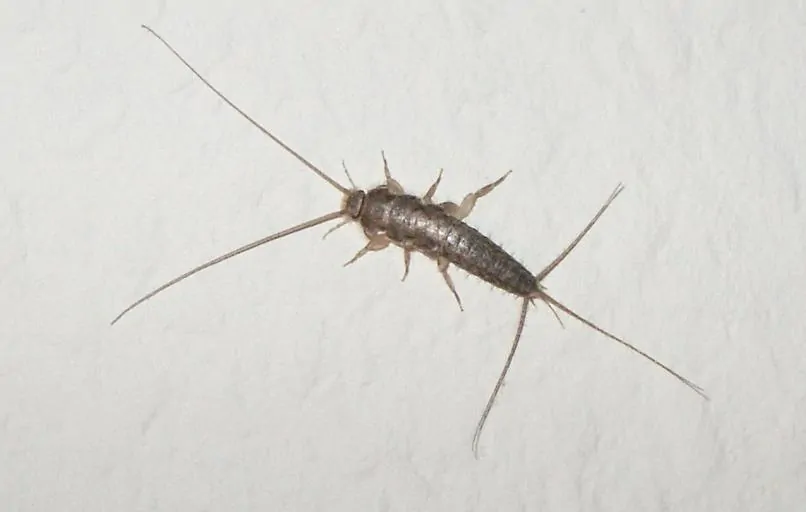Though they thrive in regions with higher humidity, Silverfish are a year-round pests common in many households throughout the United States. While silverfish pose no dangers to humans or pets and while they do not bite, they can still be destructive and annoying.
These small insects, named for their silvery color and fish-like body shapes, eat holes in fabrics and can get into pantries, attics, cupboards, and bathrooms where they seek out food sources and moisture.
If you’re dealing with a silverfish infestation in your home, don’t worry. There are plenty of methods you can use to get rid of them for good and keep them from returning. Join us today as we learn more about silverfish, what they are attracted to, and how to rid your home of these annoying pests for good.
Contents
What Are Silverfish?
Silverfish are small, silver insects that feed on a variety of materials and matter.
As we mentioned above, silverfish are insects that can be found throughout the United States, though they are most common in regions with high humidity. They can live both indoors and out and have a diverse diet that includes proteins, sugars, and carbohydrates.
Adult silverfish grow to be around ½ an inch long and have shiny brown or silver bodies. They resemble catfish with large heads, antenni, and a slimmer body. Silverfish are fast moving creatures that are active all year-round, laying eggs throughout the year in areas rich in moisture and food sources. Luckily, silverfish females only lay around 100 eggs in their lifetime, and often less than that.
These eggs generally take between two weeks and three months to hatch, at which time silverfish go through a three-stage metamorphosis. Newly hatched nymphs are white and resemble adult silverfish in appearance, and throughout their lifetime and metamorphosis, they will be active and ravenously hungry.
Silverfish are primarily a nuisance pest in the United States, though they can cause damage to personal belongings, especially fabrics and paper products. That said, it’s important to be vigilant and pay attention if you see a silverfish in your home or suspect you may be dealing with the beginning stages of a silverfish infestation.
But what has attracted silverfish into your home? And, most importantly, how do you recognize signs of a silverfish infestation before it gets out of control?
Keep reading to find out.
What Has Attracted Silverfish To Your Home?
Silverfish are attracted to food sources, shelter, and humidity.
While silverfish can live both indoors and out, they are most problematic when they get into your home. Once inside, they feast on a number of different materials including glue, cotton, starch, paper, linen, paste, oats, beef, wallpaper paste, books, upholstery, and dead insects. They also get into cereals, paper products, and will chew large holes in fabrics and clothing.
Like most pests, silverfish enter your home in search of food sources, shelter, and a safe place to lay eggs. They prefer dark, damp and humid areas, however, and will often stay away from homes that actively take steps to keep rooms ventilated.
That said, silverfish are often found residing in attics, basements, bathrooms, beneath sinks, near drains, bathtubs, or even laundry rooms. Of course, because they are such excellent little travelers, these insects can quickly move throughout entire homes until they find a good food source.
Once silverfish find a food source that they like, they’ll stay nearby until that food source is depleted.
Although silverfish insects are an annoyance to have in your home, we should note that these insects are beneficial decomposers and play an important role in our environment. When outdoors, silverfish can be helpful to gardens by eating dead insects and fungi. They are not harmful to plants and do not carry any diseases that can be transmitted to people or pets.
If they would only stay outside, they wouldn’t be a problem! Unfortunately, we humans do provide plenty of tasty food sources for these silver bugs, and this often entices them into our homes.
But how do you identify a silverfish problem inside your home? Take a look.
How To Identify A Silverfish Problem
Silverfish skin casings are a common sign of a silverfish infestation.
Because silverfish are nocturnal, it may be difficult to determine if you’re dealing with a silverfish problem if you’re not paying attention. However, there are some signs you can look for to determine if you are on the brink of a silverfish infestation inside your home.
Some of the most common signs of silverfish inside the home include:
Finding Silverfish In Bathtubs or Sinks
Silverfish will often climb into bathtubs or sinks in search of moisture and will get trapped. So while these insects are nocturnal and most active at night, if you wake up in the morning and find a silverfish or two floundering around in your bathtub or sink, you may want to start looking for other signs of a silverfish infestation around your home.
Silverfish Skin Moltings
These insects molt several times throughout their life and often leave behind skin casings. If you think you may have silverfish lurking in your home, go on a hunt for their skin. You can find these skins hidden in bookshelves, in attics, in cardboard boxes, on closet shelves, and along baseboards.
Small Holes In Fabric
Silverfish prefer protein sources and sugars. That said, they will often chew through fabrics, especially if they contain sweat or remnants of food or beverages. These holes will be small, irregular in shape, and you may notice them in clothing, bed sheets, and even wallpaper.
Yellow Stains
Yellow stains on your fabrics or papers are a good indicator of a silverfish problem. So along with looking for those telltale munch holes, keep an eye out for yellowish stains in your home.
How To Get Rid Of Silverfish – Most Popular Methods
There are many different ways you can get rid of silverfish in your home.
Silverfish are common household pests and are generally simple to get rid of using a combination of natural repellents, Insecticides, and home remedies. In rare instances or for a very severe infestation, some people may turn to professionals to help rid their homes of silverfish.
Let’s learn more about the different methods you can use to control and manage silverfish.
Natural Repellents
Getting rid of silverfish using natural repellents is one of the most recommended methods of pest control because it helps eradicate your pest problem without the use of harsh chemicals or insecticides.
Silverfish are sensitive insects who can be repelled by a number of natural ingredients that many commercial repellents include, which we will list below.
The below video may give you some other ideas on how you can remove and manage a silverfish problem in your home quickly and naturally.
Insecticides
Sometimes, a silverfish infestation can be a sign of a bigger problem. Insecticides can help not only get rid of silverfish in the home but also keep other insects from coming in as well, especially when used along the perimeter of your house.
That said, insecticides can be harmful to people, pets and the environment as many of them contain harsh chemical ingredients.
However, there are some insecticides that use natural ingredients that are less harmful and still just as effective.
Home Remedies
Because silverfish thrive in humidity and can’t survive without it, home remedies are often an effective method you can use to get rid of them. By dehumidifying your home and implementing other pest control strategies using ingredients you may already have in your fridge or pantry, you can help control and remove a silverfish problem safely and naturally.
Professionals
As we mentioned above, an abundance of silverfish in your home can be a sign of a more serious problem. Sometimes a silverfish infestation can even be a sign of other types of insect or rodent infestations. If you are dealing with a large infestation of silverfish and feel you cannot control it on your own, there are professional pest control experts that can help.
But before you call a professional to solve your silverfish problem, let’s take a look at some of the less expensive options of do it yourself pest control, starting with natural repellents.
How To Get Rid Of Silverfish Using Natural Repellents
Silverfish are not harmful to people or pets and many people opt to use natural repellents to get rid of them.
Yes, silverfish are annoying, but considering they are harmless to people and pets and generally cause only minor destruction to our personal belongings, getting rid of them using natural repellents is often an effective method that many homeowners prefer.
That said, not all natural repellents are going to work to get rid of silverfish inside of your home, so when looking for the right products, experts recommend looking for products that are specifically designed to get rid of these types of insects.
If you aren’t sure where to begin, we have listed a few of the most highly recommended natural products you can use to control a silverfish problem inside.
Diatomaceous Earth Powder
No products found.
We highly recommend Diatomaceous Earth for anyone looking for a natural way to manage pests both inside and outside of their homes. This is a dust powder that has many uses, including being an excellent and safe insect killer.
Diatomaceous Earth is a natural compound made from dried algae that works by penetrating the exoskeleton of insects like silverfish, which dehydrates and kills them. This powder is safe for people, pets and the environment and works well so long as it is dry.
Wondercide Indoor Pest Control
No products found.
Wondercide is one of our favorite products for natural pest control as it uses a combination of essential oils to help repel and kill pests while also being safe for people, pets and the environment.
We like this indoor pest control remedy for the use of silverfish because you can get it in so many different scents and essential oil mixtures, including peppermint, cedar, lemongrass, and rosemary.
Because silverfish have been shown to be repelled by peppermint and cedar, we recommend those two sprays specifically.
Mighty Mint Insect Spray
No products found.
Another insect spray that is natural and safe for indoor use is a product called Mighty Mint. Similar to Wondercide, Mighty Mint uses peppermint oil to repel and kill a number of pests like spiders, roaches, silverfish, ants, and many more.
This is a non toxic spray that is safe to use around people and pets and can be sprayed on a number of materials and surfaces and keep working long after being sprayed to prevent pests from returning.
Eco Defense Pest Spray
No products found.
We like this Eco Defense Spray because it is not only natural and safe but is also tough enough to kill and control insect infestations like bed bugs and roaches. It also works to get rid of silverfish, spiders, fleas, ants, stink bugs, mites, and earwigs.
Best of all, it doesn’t use any harsh chemicals or toxins and is completely organic, which is great for anyone looking for an organic form of pest control for their homes.
MDXconcenpts Organic Pest Control Spray
No products found.
Another organic pest control spray to control silverfish is a product by MDXconcepts. This spray uses essential oils like peppermint to get rid of a number of pests like silverfish, spiders, stink bugs, mites, roaches, ants and even fleas.
It is safe to use inside your home and even in areas where food is prepared like in kitchens and beneath kitchen sinks. We also like that it lasts long after it is sprayed to help keep pests like silverfish from returning.
CedarcideNatural Insect Repellent
No products found.
Some studies have suggested that silverfish are repelled by the heavy and overpowering scent of cedar oil, which is why we also recommend using Cedarcide as a natural form of pest control in and out of your home.
You can spray this product on a number of surfaces as it will not stain and it is even safe if it touches human skin. That said, you should not spray this product directly on plants. Cedarcide can also help get rid of mosquitoes, ticks and fleas.
Colton’s Naturals Peppermint Oil Spray
No products found.
Last on our list of natural repellents to get rid of silverfish is by Colton’s Naturals. Again, this is a spray that uses essential oils like peppermint oil and geranium oil to repel and kill silverfish in your home and keep them from returning.
This product is safe for people, pets and the environment and can be used inside the home and also as a spot treatment. It also protects against spiders, roaches, mosquitoes, stink bugs, earwigs, and ants.
How To Get Rid Of Silverfish With Insecticides
A large silverfish problem may be the sign of other issues in the home and require the use of insecticides.
While chemical insecticides are not generally required to get rid of silverfish, they can be needed in very large silverfish infestations. Remember, a large silverfish infestation may be a sign of a more serious problem in your home that will require the use of a more intensive treatment like insecticides.
Luckily, most insecticides work well to control and kill silverfish, but if you’re looking for some that consumers have specifically recommended, we’ve listed a few below.
BorActin Insect Dust Insecticide
No products found.
BorActin uses a natural compound known as boric acid to kill and control pest problems like silverfish infestations. While it does use ingredients naturally derived from organic matter, it is still considered an insecticide and can be harmful to people and pets if not used correctly.
That said, it is a safer insecticide than most and is effective against dealing with infestations of silverfish, waterbugs, ants, roaches, beetles and more.
Dekko Silverfish Paks
No products found.
Another product that uses Boric Acid but is specifically designed to manage a silverfish problem are these Silverfish Paks by Dekko. These packs are made to be placed around your home and in all the areas silverfish love to frequent like attics, basements, dresser drawers, bookshelves, and more.
That said, this product can be harmful to people and pets and should be used only as directed. You should also keep this product out of reach of children.
Tempo Ultra
No products found.
Tempo Ultra is a powerful insecticide that many experts recommend for large infestations of silverfish and other insects like spiders, roaches, ants and bed bugs. We recommend tempo if you are dealing with an abundance of silverfish and other pests in your home as it is an excellent perimeter spray as well.
This product is meant to be mixed and diluted and uses the insecticide Cyfluthrin, which can be harmful to people, pets and the environment if not used correctly. That said, this is an effective insecticide that can be used both indoors and outdoors to manage a number of different types of pest issues on your property.
Best Home Remedies To Get Rid Of Silverfish
Essential oils can repel silverfish with their overpowering scent.
One of the best ways you can get rid of silverfish and keep them from returning to your home is by implementing some home remedies that make your house less hospitable to them.
Since silverfish thrive in humidity and can’t survive without it, dehumidifying your home is one of the most efficient ways you can get rid of these bugs.
Let’s go over a few more ways to control and get rid of silverfish using home remedies.
Essential Oils
Many pests are repelled by the strong and overwhelming scent of essential oils, and silverfish are no exception. Some of the best essential oils you can use to repel silverfish include:
- Peppermint Oil
- Cedar Oil
- Lavender Oil
- Tea Tree Oil
- Cinnamon Oil
- Eucalyptus Oil
- And Citrus Oil
You can make your own essential oil spray to repel silverfish and other similar pests by mixing 10 drops of the oil of your choice into a spray bottle with one cup of water and spraying it around your home.
Spices
Silverfish are repelled by strong smelling spices like cinnamon, bay leaves, sage, and cloves. To repel silverfish, you can leave these spices in cabinets or in storage boxes, or even along bookshelves where silverfish like to hide.
Lavender
You can use lavender to help repel silverfish both inside and outside of your home. Plant lavender along the perimeter of your house to help repel silverfish, spiders, roaches, ants, and other house invading pests.
Inside your home, you can put dry lavender or lavender scent packs in cupboards, storage bins, basements and attics to help repel these insects and many others.
Mothballs
Like many pests, silverfish hate the smell of mothballs. Leaving mothballs in spaces frequently invaded by pests is a common practice in many American households.
For silverfish, we suggest leaving mothballs in basements and attics as these are two of their favorite hangouts. That said, mothballs do use a combination of chemicals to create their overwhelming scent, so use this method with caution around children and pets.
How To Get Rid Of Silverfish – When To Call A Professional
If you are dealing with a large silverfish problem, you may need to contact a professional.
Although managing a silverfish problem on your own shouldn’t be a particularly difficult task as they are less stubborn than some other household pests, an infestation can certainly be daunting. Furthermore, a very large silverfish infestation in your home can often be the sign of a more serious problem.
If you find you are dealing with a serious silverfish problem and can’t seem to remedy it no matter which methods you use, it’s time to call the professionals.
Professional pest control experts often charge between $100 and $300 to remove silverfish depending on your region and the severity of your infestation.
They can also help determine if you are dealing with a larger pest problem that has led to the abundance of silverfish in your home. Once you figure out how to get rid of silverfish, your next step should be working on how to present them from returning.
How To Prevent Future Silverfish Problems In Your Home
Prevent silverfish by decluttering and removing unused paper sources like cardboard boxes and magazines.
Silverfish are certainly annoying, but luckily they are not a difficult pest to control once you understand their needs and what attracts them.
Preventing a silverfish problem is always easier than trying to remedy an infestation, so experts recommend implementing some preventative techniques into your daily routine to help not only keep silverfish from returning to your home, but other creepy crawlies as well.
To help prevent silverfish from coming back, experts suggest you do the following:
Dehumidify Your Home
As we discussed several times above, silverfish need humidity to survive. You can help repel them and control an infestation by ventilating your home, investing in a dehumidifier, and airing out basements and attics, where these insects are generally found.
Caulk and Seal Entry and Exit Points
Sealing up your home is an important preventive step in any pest management regime. Pests enter through small openings around the perimeter of our home that we may not even realize are there, so experts suggest doing routine home maintenance checks and repairing any openings you find, even if they seem very small.
Repair ripped screens, make sure doors and windows close properly, and caulk and seal any cracks or crevices around your home and the perimeter of your home where pests can hide.
Remove Stagnant Water Sources
Because silverfish are attracted to moisture, remove stagnant water sources around your home. Clean sinks, bathtubs, and toilets often and keep drains from becoming slow or clogged. Experts also recommend covering drains in parts of the house that are not used often.
Landscape Around The Perimeter Of Your Home
Silverfish infestations often begin outside, so to keep these insects from invading your home, do some landscaping around your perimeter. Remove dead leaves and plant vegetation at least three or so feet from your house’s siding. Keep outside gutters clean and debris-free, and declutter your yard and garden to reduce dark, moist hiding places for these insects.
Declutter And Clean Your Home Often
Declutter your home to remove any dark spaces silverfish can hide. Remove unnecessary storage items and paper products, sweep and vacuum often, and store paper and fabric products in plastic bins as opposed to cardboard boxes.
Keep Food In Airtight Containers
Silverfish have a diverse diet and are especially attracted to foods like cereal and starches. You can help prevent a silverfish infestation by keeping foods in your pantry sealed and stored in containers silverfish cannot get through.
Use A Pest Repellent Year-Round
Remember, silverfish insects don’t have a season. They are active all year around and can enter your home at any time. To help prevent them, continue using a pest repellent or perimeter spray around your home and in basements and attics. Doing this will also help prevent other critters from entering like spiders, roaches, ants, and centipedes.
Last, try and keep in mind that silverfish do play a role in a healthy ecosystem. If you find them outside, remind yourself that they are not dangerous to people, pets, or plants and that they can be beneficial decomposers who help get rid of dead insects and fungi.
We hope this article has been helpful and you now have a better idea of how to manage a silverfish infestation in your home and prevent one from reoccurring in the future.
Best of luck!

Jack founded our blog after two decades of working in the pest control industry. His vast experience dealing with a wide array of pests allows him to diagnose issues quickly and get to the heart of pest problems quickly and effectively. He has serviced more than 2,000 homes over his career and there is hardly any pest situation that he has not seen before.









